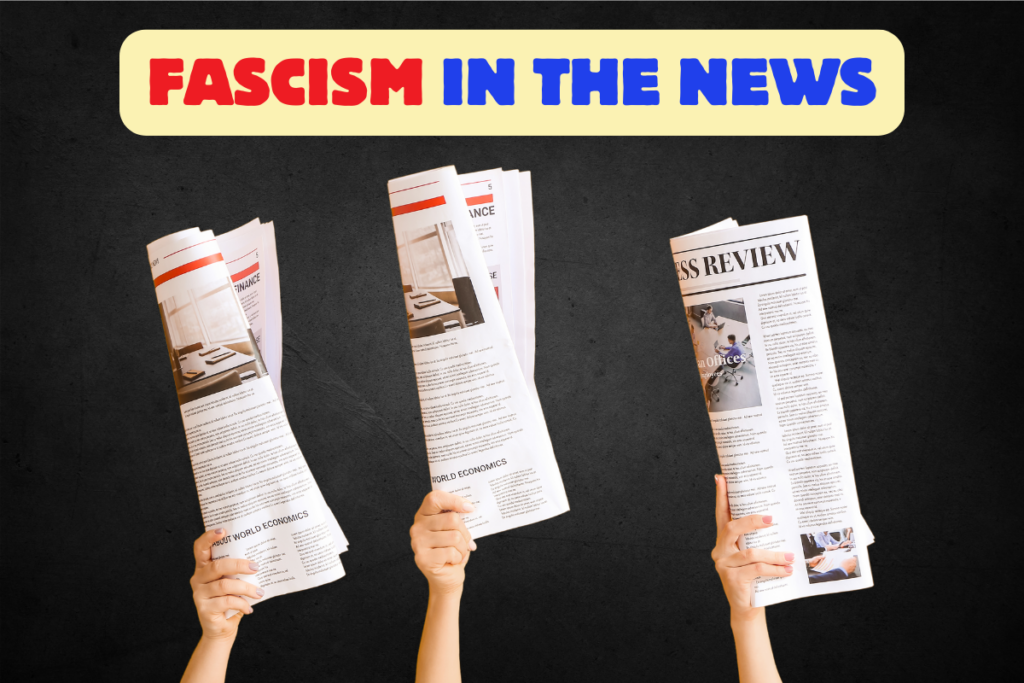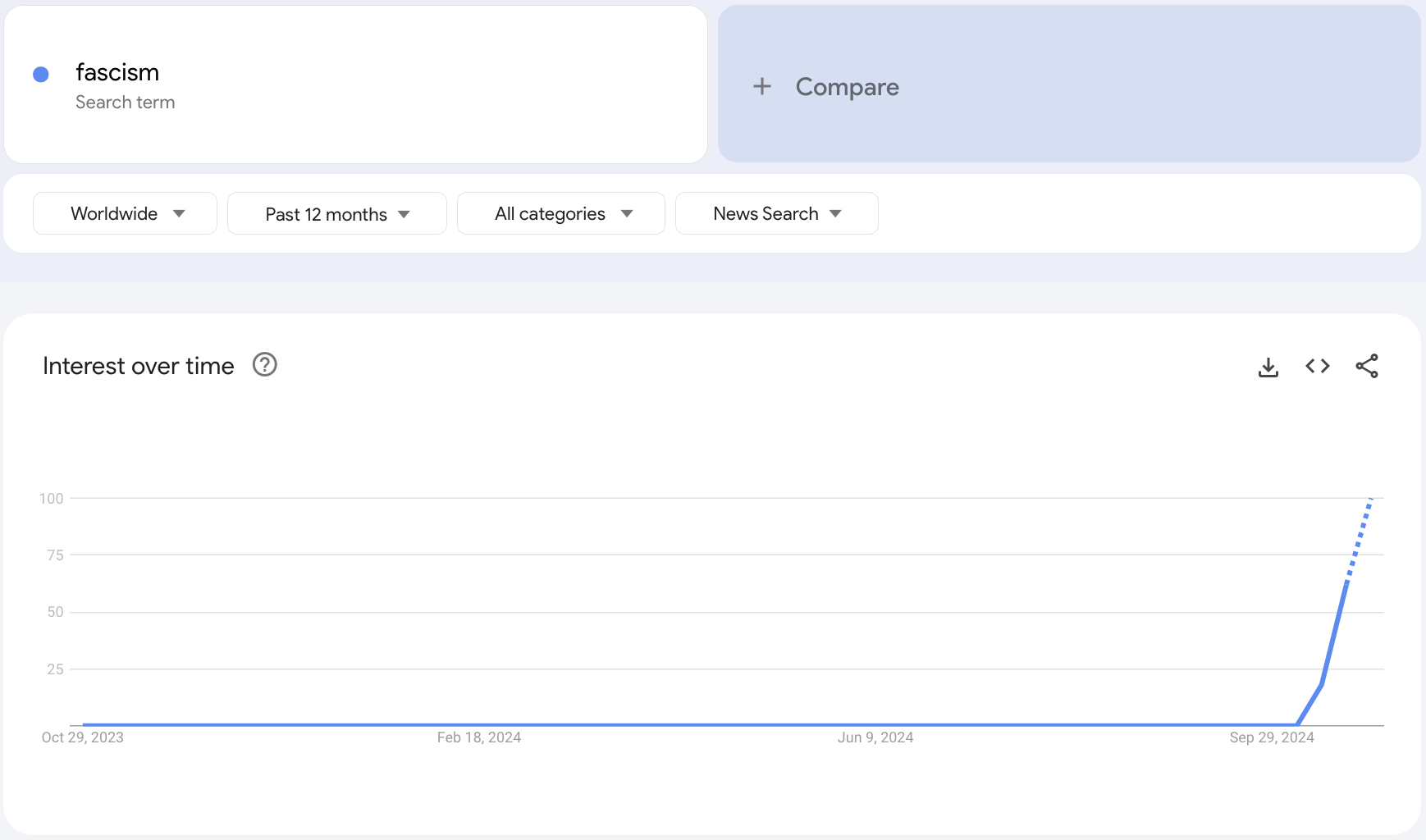‘Fascism’ in News Headlines: Key Insights and Trends

In recent months, fascism has become a prominent topic in American media, with coverage spanning ideologies, political movements, and societal debates. Based on our analysis of 17,000 articles from September 1 to October 30, this report reveals where and how the term “fascism” resonates most, offering a snapshot of public conversations and underlying sentiments. Below, we explore key findings that illustrate how fascism permeates U.S. media today.
1. Volume of Mentions: A Growing Topic of Interest
Our analysis identified 787 headlines with the term “Fascism” and 1,682 headlines with “Fascist.” This volume reflects intense scrutiny and evolving public discourse, likely fueled by political narratives and current social movements. This is also reflected in the Google Trends data looking at the last 12 months of news searches, showing a huge spike in October:

2. Audience Reach: Expanding the Conversation
With a diverse spread across media types like online news, podcasts, and Reddit, terms like “fascism” and “fascist” have sparked countless conversations, generating a total potential reach of 763.4 billion impressions — just think about how many times you’ve seen these words recently. This staggering number highlights the sheer volume of exposure these terms have across platforms, underscoring the topic’s resonance and widespread visibility. In the past year, engagement levels hit 2.8 million, indicating significant public involvement in these discussions.
3. Sentiment Analysis: Strong Opinions and Nuanced Narratives
Sentiment around fascism varies, with many articles framing it negatively, a reflection of societal resistance to extremist ideologies. However, some publications adopt a neutral stance, offering historical or analytical perspectives.
- Fascism: Predominantly neutral or negative.
- Fascist: Tends to carry stronger negative sentiment, often appearing in critiques — and in reference to presidential candidates.
On social platforms, sentiment analysis shows that 77.8% of mentions lean negative, reflecting polarized and often critical reactions. This sentiment has held steady over time, with notable spikes during key political events, underscoring how “fascism” remains a flashpoint for debate and discourse. The data captures how such terms fuel widespread conversation, driven by societal tensions and deep-rooted ideological divides.
4. Influential Voices and High-Impact Publications
A few types of influential voices have emerged as the most frequent drivers of discussions around fascism. Journalists and media personalities, including prominent editors from The Washington Post (amidst its endorsement controversies), play a central role in framing these debates. Politicians and public officials, such as Joe Biden, Kamala Harris, and Donald Trump, frequently spark public dialogue with their statements and rallies. Billionaires and tech CEOs like Elon Musk influence the conversation through their social media platforms, shaping discourse on free speech and political influence. Leading publications like Politico and The Washington Post consistently address these topics, amplifying the resonance of fascism-related debates with engaged audiences.
5. Source Types and Regional Focus
Blogs and opinion sites dominate the conversation, often presenting pointed narratives. Traditional news outlets provide analytical coverage, balancing these views. Regionally, the U.S. leads the coverage, with fascism less frequently discussed in international outlets.
6. Trends Over Time: Peaks Linked to Current Events
Coverage trends show notable spikes around major political events, such as national debates, rallies by figures like Harris and Trump, and campaign efforts across social media showcasing candidate clips—all reflecting shifts in public sentiment. Most recently, the Trump rally at Madison Square Garden generated the largest surge in headlines containing ‘Fascism’ or ‘Fascist.’
7. Keywords and Themes: The Language of Fascism

Discussions around fascism in American media often include terms like “political extremism” and “authoritarianism,” as well as frequent references to high-profile figures like Trump and Biden. Words such as “country,” “people,” “democracy,” and “support” appear prominently, indicating themes of national identity and governance. Other recurring terms include “nazi,” “propaganda,” “power,” and “vote,” reflecting concerns about political influence and ideological control. This vocabulary illustrates how “fascism” has become a central touchpoint in conversations about democratic stability, social polarization, and the broader political climate in the United States.
Conclusion: A Lens into Societal Tensions
The extensive coverage of fascism in American media underscores its role in discussing extremism and ideology. Examining these mentions provides insight into societal anxieties and pressing issues in public discourse, especially during the election cycle. As these discussions evolve, media coverage on fascism will likely reflect changing societal values and political climates.
As always, feel free to connect with us to discuss any trending topics in the media!




